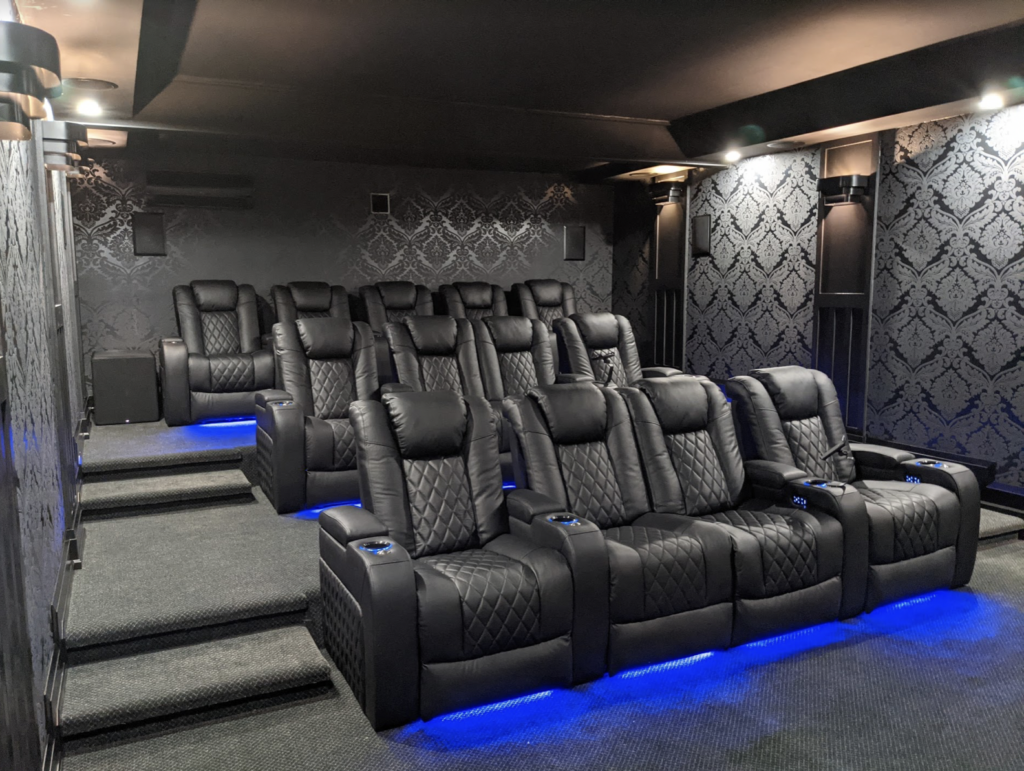Home Theater 101: Whatever You Required to Know for a Motion Picture Experience at Home
Developing a home cinema that measures up to the motion picture experience of a business theater includes cautious factor to consider of numerous components, including display selection, sound systems, and room layout. Whether you are considering the optimal display size or the ins and outs of surround sound, understanding these basics is vital.
Picking the Right Screen
When establishing up a home movie theater, picking the right display can make or damage the checking out experience - home theater design tampa. The screen works as the focal point of your setup, affecting photo high quality, viewing angles, and overall visual. Key factors to take into consideration consist of display type, size, and resolution
First, identify the suitable display dimension based on your area dimensions and seating distance. Next, choose in between various screen types, such as fixed-frame, mechanized, or retracting screens, each offering distinct benefits.
Resolution is an additional critical variable. For a really immersive experience, think about a screen created for 4K or perhaps 8K material, ensuring intensity and quality. Furthermore, think about the screen's gain, which influences brightness and contrast; a greater gain can enhance illumination in well-lit spaces, while a reduced gain may be preferable for darker atmospheres.
Picking Sound Equipment
Audio tools is a critical part of any kind of home movie theater system, considerably boosting the overall viewing experience. The choice of audio gear can establish the depth, clarity, and immersion of noise, crucial for creating a motion picture environment.
When picking audio tools, take into consideration a border stereo, which commonly includes a receiver, several speakers, and a subwoofer. A 5.1 or 7.1 channel system is suggested, where the first number stands for the audio speakers and the 2nd the speaker, providing an immersive soundscape. The receiver is the heart of the system, handling sound and video clip signals, and should sustain modern-day layouts like Dolby Atmos for an improved spatial experience.
Quality audio speakers are essential; try to find models that use a well balanced audio account with good bass action. Floor-standing speakers can create richer noise, while shelf options conserve room. Furthermore, consider wireless choices for ease of setup, although wired systems typically deliver remarkable performance.

Ideal Seating Plans
Developing an optimal home movie theater experience hinges substantially on ideal seating arrangements. The setup of seats plays a critical function in both convenience and seeing high quality, directly influencing the overall cinematic experience.
First, consider the display dimension and viewing distance. An usual standard is to position seats at a range roughly 1.5 to 2.5 times the angled size of the display. This ensures an immersive experience without straining the eyes.
Following, altitude is vital. If your seats is in a tiered format, the back rows should be greater than the front to avoid obstructions. For level seats, guarantee that the front row is not as well near the screen, which every person has a clear view.
Furthermore, take into consideration the setup in regards to social characteristics. Group seating can improve the public experience, while individual seats might be liked for individual viewing.

Last but not least, prioritize convenience with ergonomic seats that supports extensive viewing periods. Incorporating recliner chairs or supported seats can substantially enhance the experience, making the home theater a preferred location for both home entertainment and relaxation.
Lighting and Ambiance
Reliable lights and ambiance are essential parts of a well-designed home theater, as they considerably affect the viewing experience. The ideal lights can improve the motion picture feel, while inadequate choices can diminish it. For ideal outcomes, consider a layered lighting strategy that includes ambient, job, and accent illumination.
Ambient illumination offers basic illumination, making certain that the space is not totally dark, which can stress the eyes. Dimmer switches are highly suggested, enabling modifications based on the material being checked out. Job lighting, such as wall sconces or floor lights, offers practical illumination for tasks like reading or navigating the room without disrupting the general ambience.
Accent lights can be made use of to highlight architectural functions or develop focal factors, adding deepness and passion to the space. LED strip lights behind displays or along shelves can supply a subtle radiance that improves the aesthetic experience without frustrating the viewer.

Wiring and Installation Tips
A well-planned wiring configuration is crucial for accomplishing ideal efficiency in your house cinema system. Appropriate circuitry not only makes certain top notch sound and video signals but likewise enhances the total visual of your room. Begin by drawing up your design, recognizing where each part will be put, including your display, audio speakers, and receiver.
When choosing cable televisions, focus on premium, appropriately gauged wiring to reduce signal loss. HDMI cords must be made use of for video links, while audio look here speaker cable ought to match the specifications of your audio speakers and amplifier. Go with in-wall rated cable televisions to adhere to safety criteria and keep a tidy appearance.

Verdict
In recap, creating an exceptional home cinema experience needs mindful factor to consider of different elements, including screen option, audio equipment, seating plans, lights, and electrical wiring. By prioritizing these variables, a cinematic environment can be effectively reproduced, permitting for immersive seeing experiences that rival typical theater settings.
Producing a home movie theater that equals the motion picture experience of a business theater includes careful consideration of several parts, including display option, audio systems, and room design.When setting up a home movie theater, choosing the ideal display can make or damage the watching experience. Next off, pick between check this various screen types, such as fixed-frame, mechanized, or retracting screens, each offering distinct benefits. For a genuinely immersive experience, consider a display made for 4K or also 8K content, making sure intensity and clearness.In summary, read review developing a remarkable home theater experience needs mindful factor to consider of numerous elements, including display selection, audio tools, seating plans, lights, and electrical wiring.